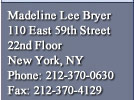|
|
|
|
 |
 Lead
Poisoning Lead
Poisoning
Lead poisoning is a preventable disease but remains the No. 1 environmental health threat to children in this country. The most common source of lead is lead paint that was used to paint interior walls before it was outlawed in 1960. If you live in a building that was built before 1960 and has peeling areas of paint, those peeling areas can give off lead dust. When children crawl around the house and put their fingers in their mouths, they are ingesting lead which goes into the bloodstream and forms deposits in the brain. In 1970 when MADELINE BRYER was a caseworker at Long Island College Hospital and saw the needless devastation that lead poisoning causes, she wrote to then-Senator George McGovern about the problem. George McGovern was so moved by her letter that he requested her permission to read her letter into the Congressional Record. Now as an attorney she is able to fight for children injured needlessly by lead poisoning because of the negligence of their landlord, physician and/or hospital.
Landlords are required to keep their property in good repair – that includes fixing areas of peeling paint. If you live in an older building with peeling paint, complain to your landlord and insist that he repair it. Make sure that your child is tested at a medical clinic or private doctor for lead poisoning. Today if a health care provider finds a child with a lead level of 10 micrograms per deciliter or more, they are required to report these lead levels to the Department of Health. If the child’s lead level is above 20 or if there are two consecutive tests above 15, the City will send a public health sanitarian to the home to inspect for lead paint violations. If the Department of Health finds lead violations, they issue an Order to the landlord to repair the violations. If the landlord fails to correct the violations within 16 days, the Department of Health is supposed to refer the case to the emergency repair service of the Department of Housing, Preservation and Development.
To help prevent significant injuries from lead, the Center for Disease Control (the "CDC") recommends that health care providers screen for infants that live or spend time in buildings constructed before 1950 or buildings constructed before 1978 that are undergoing renovations or remodeling; and children with siblings or playmates diagnosed with lead poisoning. Federal law requires children receiving Medicaid to be tested for lead at ages 1 and 2. New York Public Health Law requires that each child care provider, public and private nursery school and pre-school licensed, certified or approved by any state or local agency shall, prior to or within three months after initial enrollment of a child under six years of age, obtain from a parent or guardian of the child evidence that said child has been screened for lead. Providers who fail to comply with these requirements and standards can be held responsible should a child suffer increased lead levels because of their failure to screen.
Lead poisoning can result in permanent neurological injuries that require special education and may result in lost earning potential and life care planning. While a lawsuit cannot undue the neurological damage, it can insure that the child's future lifetime needs are provided for.
If your child or a child you know has been diagnosed with lead poisoning, call MADELINE to find out whether you have a right to sue for the damage that was done to your child so that his future needs can be insured. Help insure that landlords and health providers act responsively; call MADELINE BRYER at
(212) 370-0630.
|
|
|
Attorney Advertising. Prior
Results Do Not Guarantee a Similar Outcome.
Copyright © – Madeline Lee Bryer, P.C. – Attorneys at Law
Serious Injuries, Personal Injury Lawyers, Victims Rights,
Burn Injuries, Lead Poisoning, Burn Injuries, Scald Burns, Violent Crime, Third Degree Burns, Car Accidents,
Wrongful Death, Rape, Sexual Assault, Faulty Designed Products, Medical Malpractice
Website by
Consultwebs.com, Inc. – Law webs for law firms, lawyers
|
|





